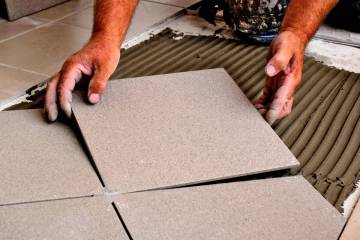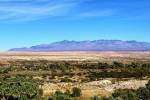Thermometer better than phone app good at predicting freeze
I went outside very early in the morning to put something in the recycling bins when I noticed frost on the lids. I thought that there was a light freeze the night before. I checked my phone weather app for the low temperature. It said the low was 45 degrees. I checked other sources for the low temperature, and it varied from upwards of 36 degrees.
My trash lids won’t lie. Phone apps are good for predicting a possible freeze and needed protection, but nothing replaces verification that an actual freeze happened.
Our National Weather Service defines a light freeze the same as a “frost.” If the temperature drops 4 degrees below that for a couple of hours, then it’s classified as a “hard freeze.”
Plants handle temperatures below a hard freeze in different ways. As a plant gets bigger it can handle colder temperatures for a longer time. Some are better at it than others.
Some plants form ice crystals that can puncture their innards as their internal water freezes. Some plants are fine if they remain frozen. They die as the ice crystals thaw out and then these plants leak their thawed-out liquid.
Some plants make their own antifreeze and handle freezing temperatures and recovery that way. Some plants use snow as an insulator to avoid hard freezing temperatures. Other plants have amazing ways to prevent them from freezing and are a topic of research at some major universities.
The National Weather Service says a light freeze happens when the winter low temperatures dip below freezing but a hard freeze occurs at about 4 degrees lower than a light freeze and stays at this temperature for a couple of hours A light freeze may damage some citrus like limes and navel oranges. Other citrus such as Meyer lemon, kumquat, Satsuma orange and grapefruit aren’t affected by those kinds of freezing temperatures.
Some tropical plants show damage from chilling injury when air temperatures drop below 50 degrees. With tomatoes and bananas, this is most obviously seen on their fruit. Other tropical plants may or may not show these same problems even though their experience is identical. They are genetically different.
As we move from tropical to subtropical fruit trees (like citrus), the effects of chilling injury compared to frost damage are more pronounced. Subtropical fruit (e.g., oranges and limes) do not show chilling injury (e.g., tomato and banana) but all subtropical trees will show damage at a variety of low temperatures just at or slightly below freezing. Again, it depends on their genetics.
Low temperatures are affected by landscape exposure and wind. South and west sides of walls are warmer for a few feet provided there is no wind. If the weather is windy, the warm or cool temperatures are blown away.
Good gardeners provide wind protection during both the desired warmer temperatures of winter and cooler temperatures of summer. Plus, strong wind can be very damaging to many plants.
Maximum/minimum thermometers aren’t expensive anymore. They are a good bench check against your phone app or the National Weather Service predictions.
Q: I planted five Japanese blueberry trees between my neighbor’s house and mine. Some of the leaves are turning red and they are dropping.
A: Japanese blueberry leaves turn red before they drop from the limbs because they are damaged. Watering too often, watering not often enough or watering every day can cause these types of problems.
If you are seeing a lot of leaves doing this, it is usually a sign of a watering problem. The soil should be wet to a depth of 12 to 18 inches each time the plants are watered. When the soil is starting to dry, it should be watered again.
Keep in mind that Japanese blueberry will grow 30 feet tall and 30 feet wide. Make sure you have the room. More plants, more water use.
When comparing this plant to others, think European olive tree but not as tough. If you’re going to grow them to full size, Japanese blueberry and European olive trees should be planted about 25 feet apart.
Q: I had an African sumac tree removed a few weeks with the stump left behind. The stump was not removed, and the roots are still there. I believe the tree removal crew treated the stump with something to prevent the tree from regrowing. Is flushing the soil with water the best treatment?
A: It’s best if you find out what was used first. They commonly use potassium nitrate. It is a nonpoisonous salt, but high concentrations can damage or even kill plants. The best removal technique for this salt is flooding the soil with water and diluting the salts several times a few days apart.
Both potassium and the nitrogen from nitrate are good fertilizers and will not pose the plants any problems after flushing. If another stump poison was used, like a borate, it may require replacement of the soil before flushing.
Q: I know it’s late for planting but can’t wait. I bought a 7-gallon, three-in-one pluot: Flavor King, Flavor Queen and Dapple Dandy. Do I need to shade this tree to protect it since I am planting during cold weather?
A: Ideally the pluot is best planted in the fall or spring when air and soil temperatures are cooling off (fall) or warming up (spring). The passion vine is best planted in the spring because it, like citrus, can freeze during very cold winters.
The pluot handles winter temperatures without any help from you. But the passion vine is subtropical, like some tender citrus, and may need some winter protection if planted in the fall.
Both plants need to be planted with amended soil three times the width of their roots. Both plants should be staked and the ground around it covered in woodchips out to about 6 feet.
However, a passion vine planted in the fall should be wrapped with a sheet or light blanket at night if freezing temperatures are threatening. Those freezing temperatures most likely will be just before sunrise so wrapping it when you are going to bed helps keep it from freezing back.
Keep the soil around the roots wet when planting. After planting, water them to settle the soil around the roots.
Make a 4-inch-deep well around each of them and hand water with a hose a couple of times before turning it over to the irrigation system. You can get rid of the well and stakes after one season of growth.
Q: Do you have any suggestions about what I can spray on the trees, branches and leaves to ensure good growth other than Miracle-Gro fertilizer?
A: Any of the water dissolving fertilizers (soluble fertilizers) will work. Manufacturers such as Grow More and Peters. Fertilizers can be used when plant nutrients are in short supply.
If you are referring to plant hormones or other chemicals, then probably not. When one or several of the 16 or 17 plant nutrients are needed, then that is the only thing you can give them that will work. Trying to figure out which one can be a headache.
For the most part, water-soluble fertilizers like Miracle-Gro are manufactured from the same fertilizer plant. You can spray the plant with a concoction of your own, but you must guess which plant nutrients the plant needs. Fertilizers are convenient and include directions on when and how much to apply.
Make sure soil amendments are added (or the plant is repotted in the case of potted plants) every three to five years. Some plants like vegetables need soil amendments and fertilizers more often.
Which fertilizers and soil amendments to use, how much to add and when to add them is a lengthy topic and deserves more space. I will provide more information on this subject in my column and in my blog.
Bob Morris is a horticulture expert and professor emeritus of the University of Nevada, Las Vegas. Visit his blog at xtremehorticulture.blogspot.com. Send questions to Extremehort@aol.com.





























